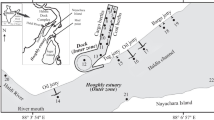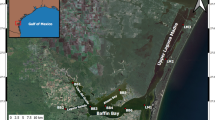Abstract
Temporal and spatial variations in phytoplankton in Asan Bay, a temperate estuary under the influence of monsoon, were investigated over an annual cycle (2004). Phytoplankton blooms started in February (>20 μg chl l−1) and continued until April (>13 μg chl l−1) during the dry season, especially in upstream regions. The percentage contribution of large phytoplankton (micro-sized) was high (78–95%) during the blooms, and diatoms such as Skeletonema costatum and Thalassiosira spp. were dominant. The precipitation and freshwater discharge from embankments peaked and supplied nutrients into the bay during the monsoon event, especially in July. Species that favor freshwater, such as Oscillatoria spp. (cyanobacteria), dominated during the monsoon period. The phytoplankton biomass was minimal in this season despite nutrient concentrations that were relatively sufficient (enriched), and this pattern differed from that in tropical estuaries affected by monsoon and in temperate estuaries where phytoplankton respond to nutrient inputs during wet seasons. The flushing time estimated from the salinity was shorter than the doubling time in Asan Bay, which suggests that exports of phytoplankton maximized by high discharge directly from embankments differentiate this bay from other estuaries in temperate and tropical regions. This implies that the change in physical properties, especially in the freshwater discharge rates, has mainly been a regulator of phytoplankton dynamics since the construction of embankments in Asan Bay.






Similar content being viewed by others
References
Adolf, J.E., C.L. Yeager, W.D. Miller, M.E. Mallonee, and L.W. Harding. 2006. Environmental forcing of phytoplankton floral composition, biomass, and primary productivity in Chesapeake Bay, USA. Estuarine, Coastal and Shelf Science 67: 108–122.
Aizdaicher, N.A., and Z.V. Markina. 2010. The effect of decrease in salinity on the dynamics of abundance and the cell size of Corethron hystrix (Bacillariophyta) in laboratory culture. Ocean Science Journal 45: 1–5.
Al-Azri, A.R., S.A. Piontkovski, K.A. Al-Hashmi, J.I. Goes, and H.R. do Gomes. 2010. Chlorophyll a as a measure of seasonal coupling between phytoplankton and the monsoon periods in the Gulf of Oman. Aquatic Ecology 44: 449–461.
Alvarez-Gongora, C., and J.A. Herrera-Silveira. 2006. Variations of phytoplankton community structure related to water quality trends in a tropical karstic coastal zone. Marine Pollution Bulletin 52: 48–60.
Arar, E.J., and G.B. Collins. 1992. In vitro determination of chlorophyll a and pheophytin a in marine and freshwater phytoplankton by fluorescence. In USEPA methods for the determination of chemical substances in marine and estuarine environmental samples. EPA/600/R-92/121, Cincinnati, OH.
Carpenter, E.J., and J.S. Lively. 1980. Review of estimates of algal growth using 14C tracer techniques. In Primary productivity of the sea, ed. P.G. Falkowski, 161–178. New York: Plenum Press.
Cloern, J.E. 1991. Tidal stirring and phytoplankton bloom dynamics in an estuary. Journal of Marine Research 49: 203–221.
Cloern, J.E., A.E. Alpine, B.E. Cole, R.L.J. Wong, J.F. Arthur, and M.D. Ball. 1983. River discharge controls phytoplankton dynamics in the northern San Francisco Bay Estuary. Estuarine, Coastal and Shelf Science 16: 415–429.
Cupp, E.E. 1943. Marine plankton diatoms of the west coast of North America. Bulletin of the Scripps Institution of Oceanography 5: 1–238.
DiToro, D.M., D.J. O'Connor, and R.V. Thomann. 1971. A dynamic model of phytoplankton populations in the Sacramento-San Joaquin delta. Advances in Chemistry Series 106: 131–180.
Dortch, Q., and T.E. Whitledge. 1992. Does nitrogen or silicon limit phytoplankton production in the Mississipi River plume and nearby regions? Continental Shelf Research 12: 1293–1309.
Dyer, K.R. 1973. Estuaries: a physical introduction, 2nd ed. Chichester: John Wiley and Sons Ltd.
Eyre, B.D. 2000. Regional evaluation of nutrient transformation and phytoplankton growth in nine river-dominated sub-tropical east Australian estuaries. Marine Ecology Progress Series 205: 61–83.
Hyun, B., Y. Sin, C. Park, S. Yang, and Y.J. Lee. 2006. Temporal and spatial variations of size-structured phytoplankton in the Asan Bay. Korean Journal of Environmental Biology 24: 7–18.
Jyothibabu, R., N.V. Madhu, K.V. Jayalakshmi, K.K. Balachandran, C.A. Shiyas, G.D. Martin, and K.K.C. Nair. 2006. Impact of freshwater influx on microzooplankton mediated food web in a tropical estuary (Cochin backwaters—India). Estuarine, Coastal and Shelf Science 69: 505–518.
Kang, Y.S., J.K. Choi, and H.M. Eum. 2003. Ecological characteristics of phytoplankton communities in the coastal waters of Gori, Wolseong, Uljin and Younggwang III. Distribution of dominant species and environmental variables. Algae 18: 29–47 (In Korean).
Lagus, A., J. Suomela, G. Weithoff, K. Heikkilae, H. Helminen, and J. Sipura. 2004. Species-specific differences in phytoplankton responses to N and P enrichments and the N:P ratio in the Archipelago Sea, northern Baltic Sea. Journal of Plankton Research 26: 779–798.
Lassen, M.F., M.E. Bramm, K. Richardson, F. Yusoff, and M. Shariff. 2004. Phytoplankton community composition and size distribution in the Langat river estuary, Malaysia. Estuaries 27: 716–727.
Lee, Y.S. 2002. An influence of inflowing freshwater on the diatom blooms in the eastern coast of Dolsan, Yosu, Korea. Journal of Korean Society of Environmental Engineers 24: 477–488 (In Korean).
Lee, S., Y. Sin, S. Yang, and C. Park. 2005. Seasonal characteristics of phytoplankton distribution in Asan Bay. Ocean Polar Research 27: 149–159 (In Korean).
Lehrter, J.C. 2008. Regulation of eutrophication susceptibility in oligohaline regions of a northern Gulf of Mexico estuary, Mobile Bay, Alabama. Marine Pollution Bulletin 56: 1446–1460.
Lucas, L.V., and J.E. Cloern. 2002. Effects of tidal shallowing and deepening on phytoplankton production dynamics: a modeling study. Estuaries 25: 497–507.
Lucas, L.V., J.R. Koseff, S.G. Monismith, J.E. Cloern, and J.K. Thompson. 1999. Processes governing phytoplankton blooms in estuaries. II: the role of horizontal transport. Marine Ecology Progress Series 187: 17–30. doi:10.3354/meps187017.
Madhu, N.V., R. Jyothibabu, K.K. Balachandran, U.K. Honey, G.D. Martin, J.G. Vijay, C.A. Shiyas, G.V.M. Gupta, and C.T. Achuthankutty. 2007. Monsoonal impact on planktonic standing stock and abundance in a tropical estuary (Cochin backwaters—India). Estuarine, Coastal and Shelf Science 73: 54–64. doi:10.1016/j.ecss.2006.12.009.
Marshall, H.G., L. Burchardt, and R. Lacouture. 2005. A review of phytoplankton composition within Chesapeake Bay and its tidal estuaries. Journal of Plankton Research 27: 1083–1102.
Mishra, R.K., B.P. Shaw, B.K. Sahu, S. Mishra, and Y. Senga. 2009. Seasonal appearance of Chlorophyceae phytoplankton bloom by river discharge off Paradeep at Orissa Coast in the Bay of Bengal. Environmental Monitoring and Assessment 149: 261–273.
Monsen, N.E., J.E. Cloern, L.V. Lucas, and S.G. Monismith. 2002. A comment on the use of flushing time, residence time, and age as transport time scales. Limnology and Oceanography 47: 1545–1553.
Murrell, M.C., J.D. Hagy III, E.M. Lores, and R.M. Greene. 2007. Phytoplankton production and nutrient distributions in a sub-tropical estuary: importance of freshwater flow. Estuaries and Coasts 30: 390–402.
Paerl, H., K. Rossignol, S. Hall, B. Peierls, and M. Wetz. 2010. Phytoplankton community indicators of short- and long-term ecological change in the anthropogenically and climatically impacted Neuse River Estuary, North Carolina, USA. Estuaries and Coasts 33: 485–497.
Parsons, T.R., Y. Maita, and C.M. Lalli. 1984. A manual of chemical and biological methods for seawater analysis. New York: Pergamon Press.
Shi, X.L., F.X. Kong, Y. Yu, and Z. Yang. 2007. Survival of Microcystis aeruginosa and Scenedesmus obliquus under dark anaerobic conditions. Marine and Freshwater Research 58: 634–639.
Sin, Y., R.L. Wetzel, and I.C. Anderson. 1999. Spatial and temporal characteristics of nutrient and phytoplankton dynamics in the York River estuary, Virginia: analyses of long-term data. Estuaries 22: 260–275.
Smayda, T.J. 1957. Phytoplankton studies in lower Narragansett Bay. Limnology and Oceanography 2: 342–359.
Smayda, T.J. 1980. Phytoplankton species succession. In Physiological ecology of phytoplankton, ed. I. Morris, 493–570. Oxford: Blackwell.
Tatavarti, R., and A. Narayana. 2006. Hydrodynamics in a Mud Bank Regime during nonmonsoon and monsoon seasons. Journal of Coastal Research 22: 1463–1473.
Thessen, A.E., Q. Dortch, M.L. Parsons, and W. Morrison. 2005. Effect of salinity on Pseudo-nitzschia species (Bacillariophyceae) growth and distribution. Journal of Phycology 41: 21–29.
Valdes-Weaver, L.M., M.F. Piehler, J.L. Pinckney, K.E. Howe, K.L. Rossignol, and H.W. Paerl. 2006. Long-term temporal and spatial trends in phytoplankton biomass and class-level taxonomic composition in the hydrologically variable Neuse–Pamlico estuarine continuum, NC, USA. Limnology and Oceanography 51(3): 1410–1420.
Vargas, C.A., and H.E. Gonzalez. 2004. Plankton community structure and carbon cycling in a coastal upwelling system. II. Microheterotrophic pathway. Aquatic Microbial Ecology 34: 165–180.
Wetz, M.S., and H.W. Paerl. 2008. Estuarine phytoplankton responses to hurricanes and tropical storms with different characteristics (trajectory, rainfall, winds). Estuaries and Coasts 31: 419–429.
Acknowledgments
The authors are indebted to Dr. J. E. Cloern (Co-Editors-in-Chief), Dr. C. L. Gallegos (Associate Editor), and two anonymous reviewers whose suggestions greatly improved the manuscript of this paper. This work was supported by grant no. R012003-000-10080-0 of the Basic Research Program of the Korea Science and Engineering Foundation, and by a Korea Science and Engineering Foundation (KOSEF) grant from the Korean government (MEST) (R01-2008-000-20388-0).
Author information
Authors and Affiliations
Corresponding author
Rights and permissions
About this article
Cite this article
Sin, Y., Hyun, B., Bach, QD. et al. Phytoplankton Size and Taxonomic Composition in a Temperate Estuary Influenced by Monsoon. Estuaries and Coasts 35, 839–852 (2012). https://doi.org/10.1007/s12237-011-9470-y
Received:
Revised:
Accepted:
Published:
Issue Date:
DOI: https://doi.org/10.1007/s12237-011-9470-y




